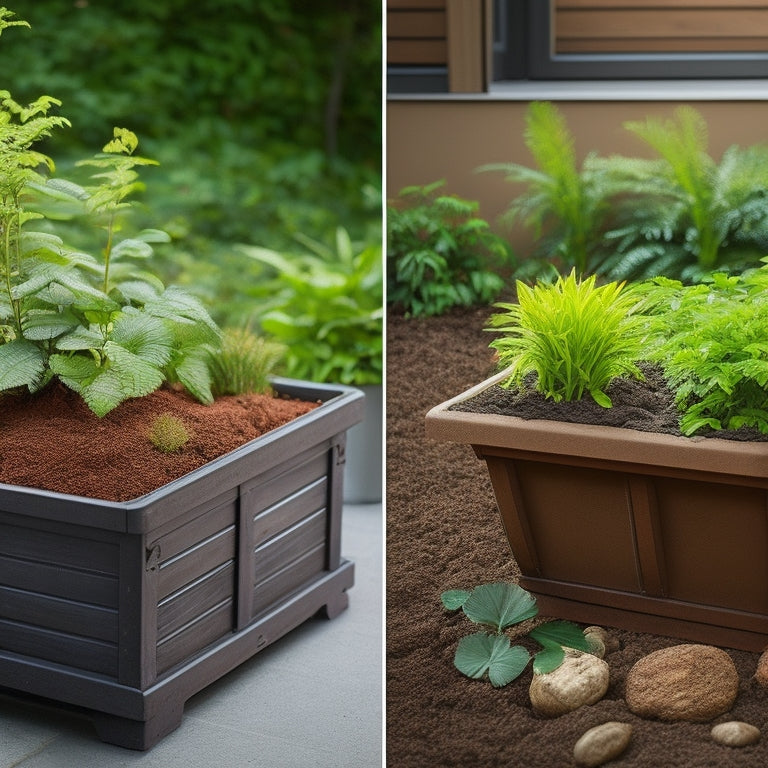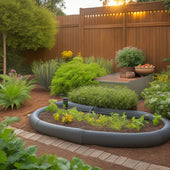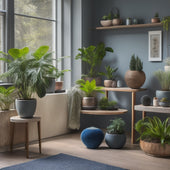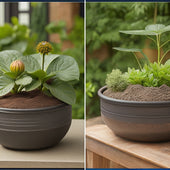
Why Do Planter Boxes Need Proper Drainage Solutions
Share
You need proper drainage solutions in planter boxes to prevent waterlogged soil, which can lead to root rot, nutrient deficiencies, and poor plant growth. Without adequate drainage, excess water can accumulate, causing oxygen deprivation and plant stress. This can result in yellowing leaves, increased pest attraction, and even plant death. By incorporating effective drainage techniques, such as layered systems and drainage holes, you can guarantee your plants receive the right balance of water, air, and nutrients. By optimizing drainage, you'll create a healthy environment for your plants to thrive, and now you're one step closer to revealing the secrets to a flourishing garden.
Key Takeaways
• Proper drainage prevents water accumulation, reducing the risk of root rot and oxygen depletion in planter ecosystems.
• Effective drainage techniques retain necessary moisture while allowing excess water to escape, promoting healthier plant growth.
• Without proper drainage, planters can become waterlogged, leading to nutrient deficiencies, pest infestations, and soil erosion.
• A well-designed drainage system guarantees the ideal balance of water and oxygen for optimal plant growth and health.
• Proper drainage solutions prevent nutrient leaching, preserve soil quality, and reduce the risk of plant diseases and pests.
Understanding Drainage in Planters
When you add soil and plants to a planter box, you're creating a miniature ecosystem that requires a delicate balance of water, air, and nutrients. Proper drainage is essential to maintaining this balance.
Without effective drainage, water can accumulate, causing roots to rot and oxygen to become depleted. This can lead to plant stress, disease, and even death.
To avoid these issues, you'll need to implement effective drainage techniques that allow excess water to escape while retaining the right amount for your plants. One approach is to incorporate a drainage layer, such as gravel or broken pottery, at the bottom of your planter. This helps to filter out excess water and prevents waterlogged soil.
Additionally, using a well-draining potting mix and avoiding overwatering can also help to maintain ideal water retention.
Cinder Block Planter Material Options
You can choose from a variety of materials to line your cinder block planter, including durable options like EPDM rubber, PVC, and nylon, which provide a waterproof barrier and protect the cinder blocks from erosion. These materials not only guarantee proper drainage but also add an extra layer of protection against moisture and weathering.
When selecting a liner, consider the type of cinder blocks you're using. For instance, if you're working with split-face blocks, a textured liner will provide a better grip and prevent slipping. On the other hand, if you're using smooth-faced blocks, a smooth liner will create a seamless look.
In terms of planter aesthetics, the liner material can also impact the overall visual appeal. EPDM rubber, for example, is available in a range of colors and can be textured to mimic natural stone. PVC, on the other hand, is often used for its sleek, modern look.
Risks of Poor Drainage Systems
Poorly designed drainage systems can lead to waterlogged planters, causing roots to rot and plants to suffocate, which can negate the benefits of a well-constructed cinder block planter. You've invested time and effort into creating a beautiful outdoor space, and it's vital to guarantee your plants thrive. Without proper drainage, you'll be left with waterlogged plants, which can lead to a range of problems.
| Risks of Poor Drainage | Effects on Plants | Consequences |
|---|---|---|
| Waterlogging | Oxygen deprivation | Root rot, plant death |
| Nutrient deficiency | Reduced growth, yellowing leaves | Stunted plants, decreased yield |
| Increased risk of pests | Attracted to moist environments | Infestations, further damage |
| Soil erosion | Washed away soil, exposed roots | Unstable plants, increased maintenance |
As you can see, the risks of poor drainage are far-reaching and can have devastating consequences for your plants. By ignoring the importance of drainage, you're putting your entire garden at risk. It's vital to prioritize proper drainage systems to guarantee your plants receive the right amount of water and nutrients to thrive.
Benefits of Proper Drainage Design
Proper drainage design guarantees your plants receive the ideal balance of water and oxygen, releasing their full growth potential and vibrant colors.
With a well-designed drainage system, you can expect improved plant health, as excess water is efficiently removed, preventing waterlogged soil that can lead to root rot. This, in turn, promotes healthy root growth, allowing your plants to absorb essential nutrients more effectively.
A moisture balance is maintained, reducing the risk of pest and disease issues that thrive in waterlogged conditions. Additionally, proper drainage helps maintain soil quality by preventing nutrient leaching, ensuring your plants receive the necessary nutrients for peak growth.
By preventing water from collecting in the soil, you also reduce the risk of soil erosion, further preserving soil quality.
With a well-designed drainage system, you can enjoy thriving plants that add beauty and value to your outdoor space. By prioritizing proper drainage, you're investing in the long-term health and success of your plants.
Effective Drainage Solution Methods
Its drainage system notwithstanding, a planter box can incorporate a variety of effective drainage solution methods to guarantee ideal water flow and soil aeration.
You can create a layered drainage system by adding materials with varying water retention properties. For instance, starting from the bottom, you can add a layer of coarse aggregate, like gravel or perlite, which allows excess water to drain quickly. Next, add a layer of activated charcoal or peat moss, which absorbs and retains water, releasing it as needed. Finally, top it off with a layer of potting mix, which provides excellent water retention for your plants' roots.
Another effective method is to incorporate a drainage gap between the planter box's bottom and the soil surface. This gap allows excess water to collect and drain out, preventing waterlogged soil.
You can also add drainage holes to the planter box itself, ensuring that excess water can escape. By implementing these drainage solution methods, you'll create an exceptional environment for your plants to thrive, with the right balance of water retention and drainage.
Frequently Asked Questions
Can I Use a Single Large Hole for Drainage in My Planter Box?
You're considering a single large hole for drainage in your planter box, but hold on a minute! A large hole mightn't be the most effective solution.
Think about it: water can collect in the bottom of your planter, and a single hole mightn't provide enough drainage, leading to waterlogged soil.
Instead, consider a planter box design that incorporates multiple smaller drainage holes of varying size to guarantee proper water flow and prevent water accumulation.
Do Self-Watering Planters Eliminate the Need for Drainage Solutions?
When you opt for self-watering planters, you're leveraging the benefits of moisture retention, allowing plants to absorb water as needed.
While this system reduces the likelihood of overwatering, it doesn't entirely eliminate the need for drainage solutions.
You'll still need to guarantee excess water can escape, preventing waterlogged soil and root rot.
Think of self-watering planters as a safeguard, not a replacement, for proper drainage.
How Often Should I Clean My Planter Box's Drainage System?
Delve into diligent drainage duties by designing a cleaning calendar.
You'll want to inspect and clean your planter box's drainage system every 1-2 months, depending on usage and climate.
Check for clogs, remove debris, and flush the system with water to guarantee ideal flow.
Regular maintenance will prevent pesky problems, preserving your plants' health and your peace of mind.
Stay on top of drainage frequency to keep your green space thriving.
Are There Any Eco-Friendly Drainage Materials for Planters Available?
You're looking for eco-friendly drainage materials for your planters, and you're in luck! There are sustainable drainage options available that align with your values.
Consider using natural filters like coconut coir or bamboo mesh to keep your planter's drainage system clear. These materials are biodegradable and compostable, making them a guilt-free choice.
Plus, they're highly effective at filtering out debris and excess water, ensuring your plants thrive in a healthy environment.
Can I DIY a Drainage System for My Planter Box Without Expertise?
You're about to commence a DIY drainage adventure, but don't get stuck in the mud!
With some basic know-how, you can create a functional drainage system for your planter box.
Start by learning effective drainage techniques, such as layering gravel and soil.
Regular planter maintenance is key, so make sure to inspect your setup often.
Conclusion
As you gaze out at your thriving planter boxes, remember that beneath the surface, a hidden world of water and roots is at play.
Just like a congested highway, poor drainage can lead to gridlock, causing roots to rot and plants to wither.
But with a well-designed drainage system, your planters become a free-flowing expressway, allowing water to exit and oxygen to enter, giving your plants the best chance to flourish.
By prioritizing drainage, you're paving the way for a healthy, vibrant garden.
Related Posts
-

Irrigation Solutions for Raised Bed Planters Made Easy
You can optimize your raised bed planters' irrigation system by understanding the complex interplay between soil type...
-

Irrigation Solutions for Raised Bed Planters Made Easy
You can optimize your raised bed planters' irrigation system by understanding the complex interplay between soil type...
-

Irrigation Solutions for Raised Bed Planters Made Easy
You can optimize your raised bed planters' irrigation system by understanding the complex interplay between soil type...
-

Irrigation Solutions for Raised Bed Planters Made Easy
You can optimize your raised bed planters' irrigation system by understanding the complex interplay between soil type...
-

Irrigation Solutions for Raised Bed Planters Made Easy
You can optimize your raised bed planters' irrigation system by understanding the complex interplay between soil type...
-

Irrigation Solutions for Raised Bed Planters Made Easy
You can optimize your raised bed planters' irrigation system by understanding the complex interplay between soil type...
-

Irrigation Solutions for Raised Bed Planters Made Easy
You can optimize your raised bed planters' irrigation system by understanding the complex interplay between soil type...
-

Irrigation Solutions for Raised Bed Planters Made Easy
You can optimize your raised bed planters' irrigation system by understanding the complex interplay between soil type...
-

Irrigation Solutions for Raised Bed Planters Made Easy
You can optimize your raised bed planters' irrigation system by understanding the complex interplay between soil type...
-

Irrigation Solutions for Raised Bed Planters Made Easy
You can optimize your raised bed planters' irrigation system by understanding the complex interplay between soil type...
-

Irrigation Solutions for Raised Bed Planters Made Easy
You can optimize your raised bed planters' irrigation system by understanding the complex interplay between soil type...
-

Irrigation Solutions for Raised Bed Planters Made Easy
You can optimize your raised bed planters' irrigation system by understanding the complex interplay between soil type...
-

Irrigation Solutions for Raised Bed Planters Made Easy
You can optimize your raised bed planters' irrigation system by understanding the complex interplay between soil type...
-

Irrigation Solutions for Raised Bed Planters Made Easy
You can optimize your raised bed planters' irrigation system by understanding the complex interplay between soil type...
-

Irrigation Solutions for Raised Bed Planters Made Easy
You can optimize your raised bed planters' irrigation system by understanding the complex interplay between soil type...
-

Irrigation Solutions for Raised Bed Planters Made Easy
You can optimize your raised bed planters' irrigation system by understanding the complex interplay between soil type...
-

Irrigation Solutions for Raised Bed Planters Made Easy
You can optimize your raised bed planters' irrigation system by understanding the complex interplay between soil type...
-

Irrigation Solutions for Raised Bed Planters Made Easy
You can optimize your raised bed planters' irrigation system by understanding the complex interplay between soil type...
-

Irrigation Solutions for Raised Bed Planters Made Easy
You can optimize your raised bed planters' irrigation system by understanding the complex interplay between soil type...
-

Irrigation Solutions for Raised Bed Planters Made Easy
You can optimize your raised bed planters' irrigation system by understanding the complex interplay between soil type...
-

Irrigation Solutions for Raised Bed Planters Made Easy
You can optimize your raised bed planters' irrigation system by understanding the complex interplay between soil type...
-

Irrigation Solutions for Raised Bed Planters Made Easy
You can optimize your raised bed planters' irrigation system by understanding the complex interplay between soil type...
-

Irrigation Solutions for Raised Bed Planters Made Easy
You can optimize your raised bed planters' irrigation system by understanding the complex interplay between soil type...
-

Irrigation Solutions for Raised Bed Planters Made Easy
You can optimize your raised bed planters' irrigation system by understanding the complex interplay between soil type...
-

Irrigation Solutions for Raised Bed Planters Made Easy
You can optimize your raised bed planters' irrigation system by understanding the complex interplay between soil type...
-

Irrigation Solutions for Raised Bed Planters Made Easy
You can optimize your raised bed planters' irrigation system by understanding the complex interplay between soil type...
-

Irrigation Solutions for Raised Bed Planters Made Easy
You can optimize your raised bed planters' irrigation system by understanding the complex interplay between soil type...
-

Irrigation Solutions for Raised Bed Planters Made Easy
You can optimize your raised bed planters' irrigation system by understanding the complex interplay between soil type...
-

7 Best Concrete Planter Ideas for Indoor Gardens
You're looking for a stylish and low-maintenance way to bring some greenery into your home, and concrete planters off...
-

7 Best Concrete Planter Ideas for Indoor Gardens
You're looking for a stylish and low-maintenance way to bring some greenery into your home, and concrete planters off...
-

7 Best Concrete Planter Ideas for Indoor Gardens
You're looking for a stylish and low-maintenance way to bring some greenery into your home, and concrete planters off...
-

7 Best Concrete Planter Ideas for Indoor Gardens
You're looking for a stylish and low-maintenance way to bring some greenery into your home, and concrete planters off...
-

7 Best Concrete Planter Ideas for Indoor Gardens
You're looking for a stylish and low-maintenance way to bring some greenery into your home, and concrete planters off...
-

7 Best Concrete Planter Ideas for Indoor Gardens
You're looking for a stylish and low-maintenance way to bring some greenery into your home, and concrete planters off...
-

7 Best Concrete Planter Ideas for Indoor Gardens
You're looking for a stylish and low-maintenance way to bring some greenery into your home, and concrete planters off...
-

7 Best Concrete Planter Ideas for Indoor Gardens
You're looking for a stylish and low-maintenance way to bring some greenery into your home, and concrete planters off...
-

7 Best Concrete Planter Ideas for Indoor Gardens
You're looking for a stylish and low-maintenance way to bring some greenery into your home, and concrete planters off...
-

7 Best Concrete Planter Ideas for Indoor Gardens
You're looking for a stylish and low-maintenance way to bring some greenery into your home, and concrete planters off...
-

7 Best Concrete Planter Ideas for Indoor Gardens
You're looking for a stylish and low-maintenance way to bring some greenery into your home, and concrete planters off...
-

7 Best Concrete Planter Ideas for Indoor Gardens
You're looking for a stylish and low-maintenance way to bring some greenery into your home, and concrete planters off...
-

7 Best Concrete Planter Ideas for Indoor Gardens
You're looking for a stylish and low-maintenance way to bring some greenery into your home, and concrete planters off...
-

7 Best Concrete Planter Ideas for Indoor Gardens
You're looking for a stylish and low-maintenance way to bring some greenery into your home, and concrete planters off...
-

7 Best Concrete Planter Ideas for Indoor Gardens
You're looking for a stylish and low-maintenance way to bring some greenery into your home, and concrete planters off...
-

7 Best Concrete Planter Ideas for Indoor Gardens
You're looking for a stylish and low-maintenance way to bring some greenery into your home, and concrete planters off...
-

7 Best Concrete Planter Ideas for Indoor Gardens
You're looking for a stylish and low-maintenance way to bring some greenery into your home, and concrete planters off...
-

7 Best Concrete Planter Ideas for Indoor Gardens
You're looking for a stylish and low-maintenance way to bring some greenery into your home, and concrete planters off...
-

7 Best Concrete Planter Ideas for Indoor Gardens
You're looking for a stylish and low-maintenance way to bring some greenery into your home, and concrete planters off...
-

7 Best Concrete Planter Ideas for Indoor Gardens
You're looking for a stylish and low-maintenance way to bring some greenery into your home, and concrete planters off...
-

7 Best Concrete Planter Ideas for Indoor Gardens
You're looking for a stylish and low-maintenance way to bring some greenery into your home, and concrete planters off...
-

7 Best Concrete Planter Ideas for Indoor Gardens
You're looking for a stylish and low-maintenance way to bring some greenery into your home, and concrete planters off...
-

7 Best Concrete Planter Ideas for Indoor Gardens
You're looking for a stylish and low-maintenance way to bring some greenery into your home, and concrete planters off...
-

What Depth Is Best for My Planter
When selecting a planter, consider the root depth requirements of your chosen plant species, as this dictates the min...
-

What Depth Is Best for My Planter
When selecting a planter, consider the root depth requirements of your chosen plant species, as this dictates the min...
-

What Depth Is Best for My Planter
When selecting a planter, consider the root depth requirements of your chosen plant species, as this dictates the min...
-

What Depth Is Best for My Planter
When selecting a planter, consider the root depth requirements of your chosen plant species, as this dictates the min...
-

What Depth Is Best for My Planter
When selecting a planter, consider the root depth requirements of your chosen plant species, as this dictates the min...
-

What Depth Is Best for My Planter
When selecting a planter, consider the root depth requirements of your chosen plant species, as this dictates the min...
-

What Depth Is Best for My Planter
When selecting a planter, consider the root depth requirements of your chosen plant species, as this dictates the min...
-

What Depth Is Best for My Planter
When selecting a planter, consider the root depth requirements of your chosen plant species, as this dictates the min...
-

What Depth Is Best for My Planter
When selecting a planter, consider the root depth requirements of your chosen plant species, as this dictates the min...
-

What Depth Is Best for My Planter
When selecting a planter, consider the root depth requirements of your chosen plant species, as this dictates the min...
-

What Depth Is Best for My Planter
When selecting a planter, consider the root depth requirements of your chosen plant species, as this dictates the min...
-

What Depth Is Best for My Planter
When selecting a planter, consider the root depth requirements of your chosen plant species, as this dictates the min...
-

What Depth Is Best for My Planter
When selecting a planter, consider the root depth requirements of your chosen plant species, as this dictates the min...
-

What Depth Is Best for My Planter
When selecting a planter, consider the root depth requirements of your chosen plant species, as this dictates the min...
-

What Depth Is Best for My Planter
When selecting a planter, consider the root depth requirements of your chosen plant species, as this dictates the min...
-

What Depth Is Best for My Planter
When selecting a planter, consider the root depth requirements of your chosen plant species, as this dictates the min...
-

What Depth Is Best for My Planter
When selecting a planter, consider the root depth requirements of your chosen plant species, as this dictates the min...
-

What Depth Is Best for My Planter
When selecting a planter, consider the root depth requirements of your chosen plant species, as this dictates the min...
-

What Depth Is Best for My Planter
When selecting a planter, consider the root depth requirements of your chosen plant species, as this dictates the min...
-

What Depth Is Best for My Planter
When selecting a planter, consider the root depth requirements of your chosen plant species, as this dictates the min...
-

What Depth Is Best for My Planter
When selecting a planter, consider the root depth requirements of your chosen plant species, as this dictates the min...


